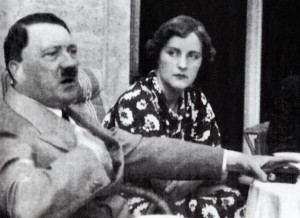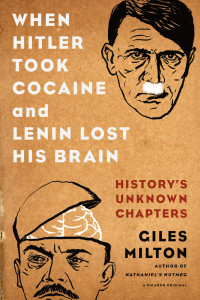WCAG Heading
by Giles Milton
In the summer of 2012, a cache of extraordinary medical documents came to light in America. They included the records of Dr Theodor Morell, personal physician to Adolf Hitler, and notes written by four other doctors who treated the Führer.
At first glance, the documents seemed little more than an historical footnote, one to be added to the mass of existing material about Hitler. But footnotes can often conceal nuggets of gold, and this one opened a wholly unknown chapter of history. The cache revealed that the Führer was being prescribed a heady cocktail of drugs, including cocaine, amphetamines and testosterone. Indeed he was taking up to 80 drugs a day, at the same time as masterminding his attempted conquest of the world.
WCAG Heading
Hitler’s English Girlfriend – Unity Mitford
Unity Mitford was a plain-looking woman with bad teeth and a plump belly. But she had never been troubled by her strange looks and knew that she was more likely to catch the man of her dreams by speaking her mind rather than flaunting her body.
In the summer of 1934, she traveled to Munich in the hope of meeting her idol, Adolf Hitler. Although he was Führer of Germany, it was relatively easy to see him in public since he was accustomed to eating at the same cafes and restaurants each day. When Unity learned that he often had lunch at the Osteria Bavaria, she began eating there as well. She did everything she could to catch his attention. Yet ten months were to pass before Hitler finally invited the persistent English girl to his table. The two of them chatted for half an hour and quickly realized they were soulmates.
‘It was the most wonderful and beautiful [day] of my life,’ wrote Unity Mitford to her father. ‘I am so happy that I wouldn’t mind a bit, dying. I’d suppose I am the luckiest girl in the world. For me he is the greatest man of all time.’
Her feelings were reciprocated. Hitler was particularly intrigued by Unity’s middle name, Valkyrie. And he was fascinated to learn that her grandfather had translated the anti-Semitic works of Houston Stewart Chamberlain, one of his favorite authors.

Image is in the public domain via TheDailyMail.co.uk
Hitler began to see more and more of his fair-haired English companion, much to the annoyance of his ‘official’ girlfriend, Eva Braun. ‘She is known as the Valkyrie and looks the part, including her legs,’ wrote Braun scornfully in her diary. ‘I, the mistress of the greatest man in Germany and the whole world, I sit here waiting while the sun mocks me through the window panes.’
Unity was now introduced to members of Hitler’s inner circle. She got along particularly well with the thuggish Julius Streicher, publisher of the vitriolic anti-Semitic newspaper Der Stürmer.
When Unity delivered a particularly racist diatribe against the Jews, Streicher asked if he could print it in his paper. Unity Mitford was flattered. ‘The English have no notion of the Jewish danger,’ began her article. ‘Our worst Jews work only behind the scenes. We think with joy of the day when we will be able to say England for the English! Out with the Jews! Heil Hitler!’ She ended her text with the words: ‘Please publish my name in full, I want everyone to know I am a Jew hater.’
Hitler was so pleased with what Unity Mitford had written that he awarded her a golden swastika badge as well as a private box at the 1936 Berlin Olympics.

She now became one of the Führer’s intimates, visiting him on numerous occasions and constantly expressing her admiration for him. He was no less smitten with her: in 1938, he even offered her an apartment in Munich. Unity had high hopes of replacing Eva Braun in his affections. By now, her behavior had aroused the suspicions of the British Secret Service. The head of MI5, Guy Liddell, was particularly alarmed by her closeness to Hitler. He felt that her friendship with him warranted her being put on trial for high treason.
Unity refused to leave Germany, even after Britain’s declaration of war on 3 September 1939. Yet she was deeply depressed by what had happened, not least because of the implications it had for her relationship with Hitler.
She took herself to the English Garden in Munich, held to her head the pearl-handled pistol that had been given to her by Hitler and pulled the trigger.
She was badly wounded but, amazingly, survived. Hospitalized in Munich (the bills were paid by Hitler), she was eventually moved to Switzerland. When she had partially recovered, her sister, Deborah, flew to Bern in order to take her home to England.
‘We were not prepared for what we found: the person lying in bed was desperately ill. She had lost two stone (28 pounds), was all huge eyes and matted hair, untouched since the bullet went through her skull.’
What happened next remains shrouded in mystery. According to the official account, she was taken to the family home at Swinbrook, Oxfordshire. She learned to walk but never made a full recovery. She eventually died in 1948 as a result of meningitis caused by the bullet in her brain. But there is also a more intriguing story about her return to England. There are rumors, never confirmed, that she was taken to a private maternity hospital in Oxford. Here, in absolute secrecy, she gave birth to Hitler’s love child.

The woman who made the claim, Val Hann, is the niece of the hospital’s former manager, Betty Norton. Betty had told the story to her sister, who in turn passed it on to Val.
If true, it would mean that Hitler’s child is quite possibly still alive and living somewhere in England.
But the facts will never be known for certain: Betty Norton died long ago and the maternity hospital neglected to register the babies who were born during the war.
Giles Milton is the author of When Hitler Took Cocaine: History’s Unknown Chapters, a writer and journalist. He has contributed articles to most of the British national newspapers as well as many foreign publications, and specializes in the history of travel and exploration. In the course of his researches, he has traveled extensively in Europe, North Africa, the Middle East, and the Americas. He has written several books of nonfiction, including the bestselling Nathaniel’s Nutmeg, and has been translated into fifteen languages worldwide. He is the author of the novel Edward Trencom’s Nose.
